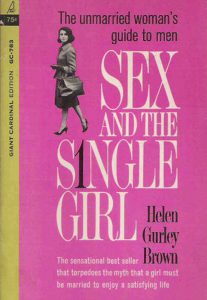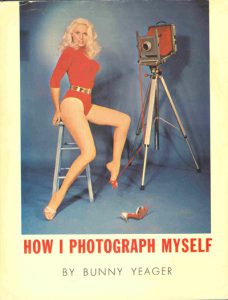 How I Photograph Myself, by Bunny Yeager, 1964
How I Photograph Myself, by Bunny Yeager, 1964
I pulled this gem from the SFPL’s 3rd floor page desk, which turned out to be quite a production. Apparently the book could only be looked at in a certain spot, a particular table next to the Art and Music reference desk, under the eagle eye of the reference librarian. I speculated it might be because Bunny Yeager’s photographs—pin-ups, cheesecake, calendar art—fell into some theft vulnerability category the librarians have made up. After all, Bunny Yeager is best known for her Betty Page photos, and Betty Page has quite the cult following, what with bio-pic, books, and a store on Haight Street named after her.
I was hoping that the Bunny Yeager book would tell me more about her career—her transformation from pin-up model to photographer (what’s not to like about the theoretically significant male gaze of the typical cheesecake photographer being replaced by the gaze of the model herself on both herself and fellow models?) and particularly the business end of the pin-up photo biz (who bought the pictures? For how much?). Readers of the Lesbian Career Girl series may have figured out that Dolly, who appears in Lois Lenz, Lesbian Secretary, and the forthcoming Maxie Mainwaring, Lesbian Dilettante, is in part inspired by Bunny Yeager.
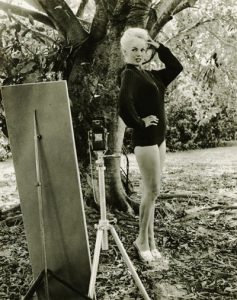
DIY A-Go-Go!
Turns out, the title is absolutely literal. This is a guide for women who want to make “glamor” photos of themselves and are too shy to go to a professional (the assumption is that means male) photographer.
As such, it’s a delight. Any time I come across evidence that today’s trends are nothing new, I’m happy. This book takes today’s DIY spirit and applies it to mid-century’s cheesecake photography. Bunny schizophrenically covers topics from both sides of the camera, listing possible poses in one chapter and advising on lighting in the next. She even includes budget-conscious instructions for making a “swimsuit” with a plunging neckline out of a few yards of black wool. This is the one-man-band version of glamor photography.
I learned a lot from this book: the importance of developing multiple smiles, and the many posing possibilities–“standing poses, kneeling poses, reclining poses, sitting poses, poses with props.” (Each category gets its own chart of silhouetted poses to illustrate). I took to heart Bunny’s advice on the importance of props: “Being an experienced model, I can pose for hours without props if I must, but with the addition of these excellent posing assistants, I can go on indefinitely.” One imagines a Guiness Book of World Records entry—longest time spent striking sucessive poses. Props are also helpful for concealing imperfections: “Scars, stretch marks and bruises can be hidden by a prop held gracefully,” she advises. Get out your wagon wheels, towels, and telephones, ladies!
Long before feminists were talking about acceptance for all shapes and sizes, Bunny was there, albeit with a 1964 sensibility. “Near perfection may be obtained with girdles, waist cinchers, padded bras, etc. in everyday life…but what can you do to disguise flaws in the nude figure?” she asks, and answers promptly “Very little.” So just accept your body as it is, she advises. Everyone has some feature worth highlighting in a photograph: “Even when the bosom is impossible to work with, there is always the buttocks and back.”
The book is illustrated abundantly with photos of Bunny, by Bunny. I couldn’t always tell which ones were or weren’t Bunny, probably because of the dazzling array of different smiles, props, and poses she used, not to mention the changing hair color.
Bunny’s matter-of-factness and all-American enthusiasm for her corner of the soft-porn market is infectious: “Come on, admit you like to take off your clothes, and make some good photographs!”
 The Odd Ones, Edwina Mark, Berkley Books, 1959
The Odd Ones, Edwina Mark, Berkley Books, 1959
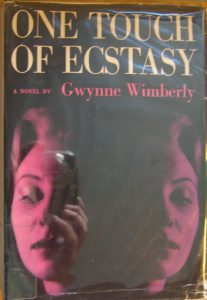 One Touch of Ecstasy, by Gwynne Wimberly, Frederick Fell, Inc. 1959.
One Touch of Ecstasy, by Gwynne Wimberly, Frederick Fell, Inc. 1959. How I Photograph Myself, by Bunny Yeager, 1964
How I Photograph Myself, by Bunny Yeager, 1964



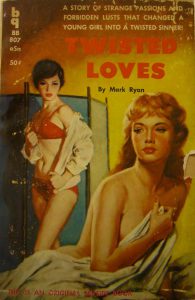 Twisted Loves, by Mark Ryan “an original Bedside Book”
Twisted Loves, by Mark Ryan “an original Bedside Book”